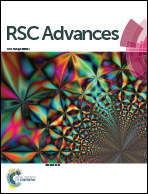Decolorization of dark-colored waste cotton fabric using redox decoloring agents†
Abstract
A huge quantity of dark-colored waste cotton fabrics with a high content of dye powder is dumped in landfills and incinerated, which is a waste of resources and pollutes the land and atmosphere. Also, it is meaningful to effectively strip the color from these dark-colored waste cotton fabrics with minimal damage to the strength of the textiles. In this study, a dark-colored waste cotton fabric dyed with reactive dyes was subjected to chemical treatment with redox decoloring agents. The effects of various treatments on the coloration and mechanical properties of the fabric were compared. This work developed an effective Na2S2O4–H2O2 system for decolorizing waste cotton fabric, with numerous advantages over conventional physicochemical approaches including achieving a CIE whiteness index of 74.1, tensile strength loss of 24.0%, weight loss of 1.2%, decoloration rate of 97.8%, and a degree of polymerization of 735.3. Furthermore, a mechanism was proposed to explain the two-step synergistic decolorization process.



 Please wait while we load your content...
Please wait while we load your content...